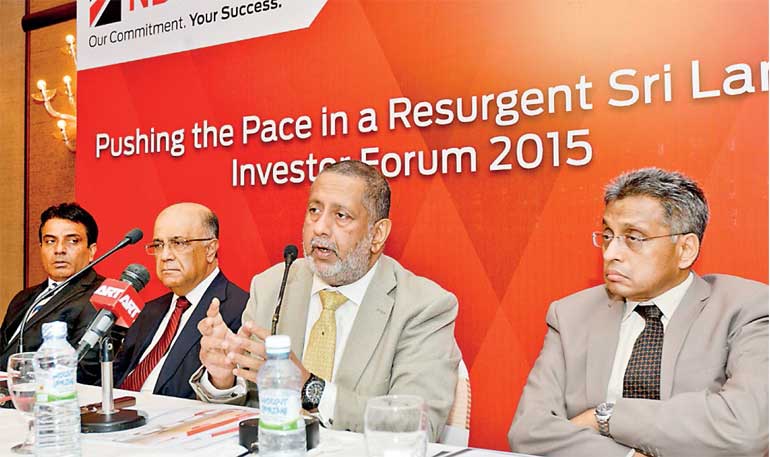Friday Dec 05, 2025
Friday Dec 05, 2025
Tuesday, 17 November 2015 00:07 - - {{hitsCtrl.values.hits}}
By Shehana Dain
NDB Bank at group level recorded a decline of PAT by 30% to Rs. 2.3 billion while PAT of the bank stood at 2.7 billion down by 5% in its interim financial statements for September.
The bank outlined four core factors which resulted in its short fall compared to last year and its future growth strategies at an investor forum last week.
NDB Bank CEO Rajendra Theagarajah stated that Rs. 980 million dip was a result of the deprivation of asset and liability mismatch opportunities which caused the bank a loss of Rs. 500 million. Additionally the declining interest rates resulted in a margin squeeze of Rs. 250-300 million and the Investment Banking unit of the group made a loss of Rs. 200 million due to challenges in the capital market. Moreover the group PAT also had an adverse impact of the one off operational loss of Rs. 170 million.
He went on to say that the bank has recognised the declining interest rates as a lagging factor for profit growth. In this context he noted: “Margin squeeze is here to stay. We are hoping to address this by growing our CASA base, aggressively expanding our card business attracting the merchant customers and growing our retail banking operations.”

NDB Bank CEO Rajendra Theagarajah addresses the Investor Forum along with from left: NDB Bank Group CFO Faizan Ozman, Chairman N. G. Wickremeratne, and NDB Capital CEO Vajira Kulatilaka - Pic by Daminda Harsha Perera
The bank has also seen a loan growth of 17% and deposit growth of 13% while its asset base grew by 10%. Commenting on its loan and deposit growth Theagarajah said: “While seeing a concerning and fairly flat first and second quarter, at the end of the third quarter we see that loan growth is picking up. Even in October I see the same trend. In March we predicted a 12 month loan growth of 20% and deposit growth of 17% and as at today with the skewness we are very optimistic about reaching our targets.”
For the quarter ended 30 September at group level NDB’s fee and commission income rose 13% to Rs. 751 million helped by other income. Interest income was down by 2% to Rs. 5.33 billion, interest expenses rose 1.2% and net interest income fell 7.8% to Rs. 1.9 billion.
NDB Bank’s loans grew 10% to Rs. 192 billion, while available for sale financial instruments rose 34% to Rs. 24 billion, during the first nine months in FY15.
The bank made a fair value loss of Rs. 72 million on the available for sale portfolio and Rs. 371 million on a cash flow hedge, which was charged to the statement of comprehensive income.
NDB Bank’s total assets grew by 6% to Rs. 279 billion of which loans and receivables stood at Rs. 192 billon up by 10%. Total liabilities grew 6% to Rs. 254 billion while customer deposits grew 12% to Rs. 169 billion.
The Tier I capital adequacy ratio of the Group as at 30 September 2015 was 12.39% whilst the Tier I & II ratio was 16.82% and compares with regulatory minimum ratio requirements of 5% and 10% respectively.
With regard to shareholder returns indicators, the Group Return on Equity (ROE) was 10.55%. Basic earnings per share (EPS) closed at Rs. 16.13, whilst the net book value per share of the bank for the quarter was Rs. 144.36.
Elaborating on NDB’s stance regarding the super gains tax (SGT) he highlighted: “At the end of the full year 2014 even though we hadn’t made a provision for SGT because it wasn’t clear, the bank had quantified the impact of SGT for the full year’s profit in 2014 and had put that as a note in the financial statements. It was Rs. 854 million. The industry along with the regulators has agreed to when it becomes law it won’t be a direct hit to the Profit and Loss statements as it will be charged for the reserves.”
NDB has paid the first instalment of the SGT and the balance will be paid by 31 December this year.
According to research by Asia securities banking sector performance for the September quarter (3Q15) is expected to be hampered by losses made on their investments in the government securities, as the treasury yields saw edging up.
However the impact on NDB with regard to mark to market on bond trading is considerably less than its peer banks in the industry.
“In our balance sheet the impact regarding this is less than Rs. 100 million because we consciously managed the exposure for fixed income.”
Furthermore he went on to say that the board is confident on turn around results and is unshaken to achieve its final goal.
“As a tool to walk the talk, we declared a Rs. 7 interim dividend even which is the same as last year despite the dip in PAT; to show the conviction of the board on the future of the strategic plan ahead.”
Pic by Daminda Harsha Perera